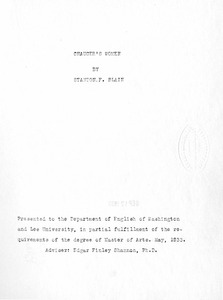| dc.description.abstract | Chaucer has given us an array of femininity unsurpassed by any other poet. From every walk in life he drew his heroines and in every conceivable color he painted them. . . . A comprehensive study of all of Chaucer's heroines would be an endless task, and yet how can we say that one of them is more deserving of our attention than another? No one of them is without merit, and those who would prove interesting to some might prove less so to others. . . . Tnere are five, however, that are generally conceded to display best Chaucer's ability to portray character, and it is to these that I shall confine myself here. Criseyde was chosen because she is the heroine of the "Troilus and Criseyde" which Professor Root so aptly terms Chaucer's "only work of large dimensions, requiring a sustained effort of the poetical imagination," which he brought to completion.[3] Although he does not mention Boccaccic by name, Chaucer's principle source was undoubtedly Boccaccio's "Filostrato" [4-5] The entire story is one of dramatic, emotional characterization, rather than action, and for this reason is particularly interesting to us. Emily is our best illustration of Chaucer's ability to portray character by suggestion. Here again Chaucer drew from Boccaccio, this time from his "Teseide." For the original of Constance, Chaucer went to the "Anglo-Norman Chronicle" by Nicholas Trivet. Through her we see what Chaucer was capable of, in portraying that most difficult type -- the perfect, passive woman. According to Chaucer, Petrarch furnished the original of Griselda, but we know that Petrarch made his translation from the tenth story of the tenth day of Boccaccio's "Decameron," and it is to this that we go for the original of this patient lady. Here, Chaucer uses both suggestion and ation to give us character; and to these two he adds self-revelation and produces his great, original creation, Alice, the Wife of Bath. [From introductory section] | en_US |
| dc.rights | This material is made available for use in research, teaching, and private study, pursuant to U.S. Copyright law. The user assumes full responsibility for any use of the materials, including but not limited to, infringement of copyright and publication rights of reproduced materials. Any materials used should be fully credited with the source. | en_US |
